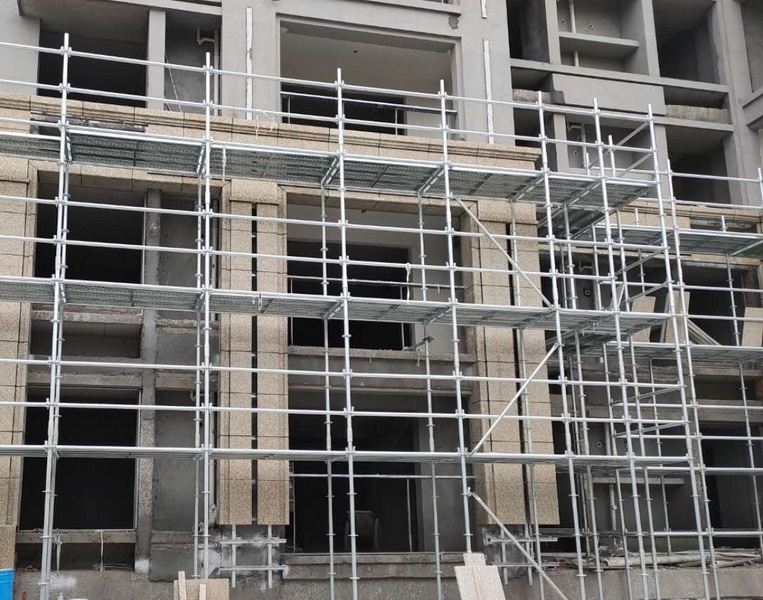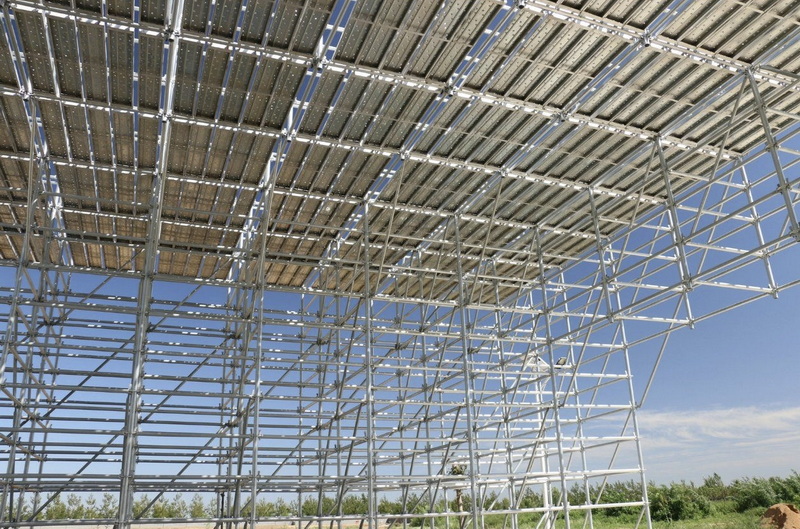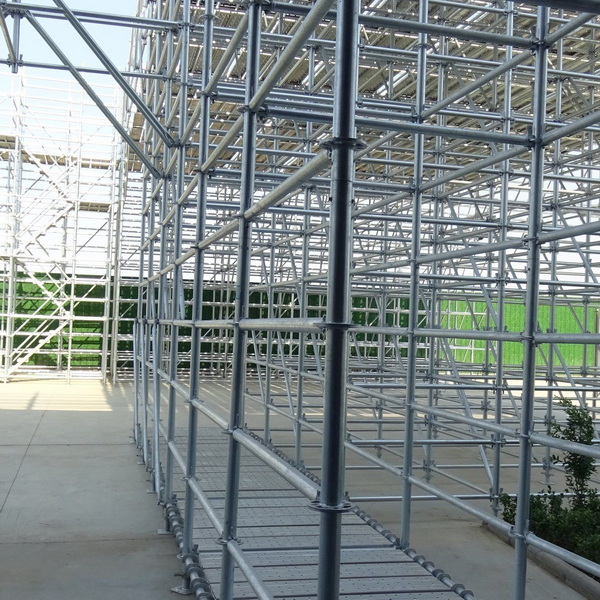Content Menu
● Introduction to Modular System Scaffolding
● Benefits of Modular System Scaffolding
● Assembly Process of Modular System Scaffolding
>> Step 1: Preparation
>> Step 2: Ground Preparation
>> Step 3: Erecting the Base
>> Step 4: Adding Vertical Standards
>> Step 5: Installing Horizontal Ledgers
>> Step 6: Adding Diagonal Braces
>> Step 7: Placing Decks
● Dismantling Process of Modular System Scaffolding
>> Step 1: Safety Checks
>> Step 2: Remove Decks
>> Step 3: Remove Diagonal Braces
>> Step 4: Dismantle Horizontal Ledgers
>> Step 5: Dismantle Vertical Standards
>> Step 6: Store Components
● Advanced Techniques for Modular System Scaffolding
>> Using Scaffolding Software
>> Training and Certification
>> Incorporating Fall Protection Systems
● Case Studies
>> Case Study 1: High-Rise Building Construction
>> Case Study 2: Bridge Maintenance
>> Case Study 3: Industrial Plant Renovation
● Conclusion
● FAQ
>> 1. What is modular system scaffolding?
>> 2. How does modular scaffolding differ from traditional scaffolding?
>> 3. What safety measures should be taken during scaffold assembly?
>> 4. Can modular scaffolding be used in different environments?
>> 5. What tools are required for assembling modular scaffolding?
● Citations:
Modular system scaffolding has become an essential component in modern construction, offering flexibility, safety, and efficiency. This article will explore the assembly and dismantling processes of modular scaffolding, highlighting its advantages and providing practical insights.

Introduction to Modular System Scaffolding
Modular scaffolding, also known as system scaffolding, is constructed from standardized components such as frames, braces, and connectors. This type of scaffolding is designed for quick assembly and disassembly, making it ideal for various construction projects. The modular design allows for easy transportation and storage, contributing to its growing popularity in the industry.
Benefits of Modular System Scaffolding
- Time Efficiency: Modular scaffolding can be assembled and dismantled quickly compared to traditional scaffolding systems. The simplicity of connecting the components significantly reduces labor time.
- Safety: The standardized components reduce the risk of errors during assembly, enhancing worker safety. Engineered to meet stringent safety standards, these systems incorporate built-in safety features.
- Versatility: Suitable for various applications, including residential, commercial, and industrial projects. Its modular design allows it to conform to irregular shapes and heights.
- Cost-Effectiveness: Reduced labor costs due to faster assembly times. The system's reusable components also contribute to long-term savings.
Assembly Process of Modular System Scaffolding
Step 1: Preparation
Before beginning the assembly, ensure that all components are available and in good condition. This includes:
- Frames
- Braces
- Decks
- Connectors
Verify that all parts have been inspected and meet the necessary quality standards. Damaged or substandard parts should be removed from the site.
Step 2: Ground Preparation
Ensure that the ground is level and stable. This will provide a solid foundation for the scaffolding structure. If the ground is uneven or soft, use base plates or mud sills to distribute the load evenly.
Step 3: Erecting the Base
1. Position the Base Frames: Lay out the base frames according to the project specifications. Use a measuring tape to ensure proper spacing.
2. Secure Connections: Use connectors to secure the frames together at designated points. Locking pins or clamps are typically used to ensure a firm connection.
Step 4: Adding Vertical Standards
1. Install Vertical Standards: Insert vertical posts into the base frames. Ensure they are correctly aligned and securely locked.
2. Check Alignment: Ensure that all vertical standards are plumb and aligned correctly. Use a level to verify vertical alignment.
Step 5: Installing Horizontal Ledgers
1. Attach Ledgers: Connect horizontal ledgers between vertical standards using locking mechanisms. These ledgers provide lateral support and create a platform for the decks.
2. Ensure Stability: Check that all connections are secure. Double-check that all locking mechanisms are properly engaged.
Step 6: Adding Diagonal Braces
1. Install Diagonal Braces: Attach diagonal braces to enhance stability. These braces prevent swaying and add strength to the scaffold structure.
2. Cross-check Connections: Verify that all braces are properly secured. Ensure that the braces are properly tensioned for maximum effectiveness.
Step 7: Placing Decks
1. Lay Decks: Position decks on top of the assembled structure. Ensure that they fit snugly and securely.
2. Secure Decks: Ensure that decks are locked in place to prevent movement. Use locking pins or clips to keep the decks from shifting or lifting.
Dismantling Process of Modular System Scaffolding
Dismantling modular scaffolding requires careful planning to ensure safety and efficiency.
Step 1: Safety Checks
Before dismantling, conduct a thorough inspection of the scaffold structure:
- Ensure all components are intact. Check for any signs of damage or wear.
- Confirm that no workers are on or around the scaffold. Clear the area beneath the scaffold to prevent injuries from falling components.
Step 2: Remove Decks
1. Clear Work Area: Remove any tools or materials from the decks. Ensure a clear and unobstructed work space.
2. Dismantle Decks: Carefully take down the decks from top to bottom. Use a hoist or other mechanical means to lower heavy decks safely.
Step 3: Remove Diagonal Braces
1. Detach Braces: Remove diagonal braces next, ensuring stability is maintained during this process. Work from the top down to prevent instability.
2. Store Components Safely: Place removed components in a designated area for inspection. Stack components neatly to prevent tripping hazards.
Step 4: Dismantle Horizontal Ledgers
1. Remove Ledgers: Take down horizontal ledgers while ensuring that vertical standards remain secure. Use safety harnesses to prevent falls.
2. Check Stability Continuously: Monitor the structure's stability throughout this step. Ensure that the scaffold does not become unstable as components are removed.
Step 5: Dismantle Vertical Standards
1. Remove Vertical Standards: Carefully take out vertical posts from their bases. Use a controlled lowering method to prevent damage to the posts.
2. Inspect Components: Check each component for damage before storage. Discard any damaged parts to prevent future use.
Step 6: Store Components
After dismantling, organize and store all components properly for future use. Store components in a dry, secure location to prevent corrosion and damage.

Advanced Techniques for Modular System Scaffolding
To maximize efficiency and safety when working with modular system scaffolding, consider the following advanced techniques:
Using Scaffolding Software
Employing scaffolding software can streamline the design, planning, and management of modular scaffolding projects. These software solutions offer features such as:
- 3D Modeling: Visualize the scaffold structure before assembly to identify potential issues.
- Load Calculations: Ensure that the scaffolding can safely support the intended load.
- Inventory Management: Track the location and condition of scaffolding components.
Training and Certification
Ensure that all workers involved in assembling and dismantling modular scaffolding are properly trained and certified. Training programs should cover:
- Safety Procedures: Teach workers how to identify and mitigate potential hazards.
- Assembly Techniques: Provide hands-on training in the proper assembly and dismantling techniques.
- Equipment Inspection: Train workers to inspect components for damage and wear.
Incorporating Fall Protection Systems
Integrating fall protection systems into the scaffold design is critical for worker safety. Common fall protection measures include:
- Guardrails: Install guardrails along the perimeter of the scaffold to prevent falls.
- Safety Nets: Use safety nets to catch workers in the event of a fall.
- Personal Fall Arrest Systems (PFAS): Provide workers with harnesses and lanyards to arrest falls.
Case Studies
To further illustrate the benefits of modular system scaffolding, let's examine a few case studies:
Case Study 1: High-Rise Building Construction
In the construction of a high-rise building, modular scaffolding was used for exterior façade work. The modular design allowed workers to quickly adapt the scaffold to the building's changing height and shape. This resulted in significant time savings and improved worker safety.
Case Study 2: Bridge Maintenance
For bridge maintenance, modular scaffolding provided a stable and adaptable platform for workers to perform repairs. The system's ability to conform to the bridge's curved surfaces made it an ideal solution.
Case Study 3: Industrial Plant Renovation
During an industrial plant renovation, modular scaffolding was used to provide access to elevated equipment and structures. The system's modularity allowed it to be easily reconfigured to meet the changing needs of the project.
Conclusion
The ease of assembling and dismantling modular system scaffolding is one of its most significant advantages in construction projects. By utilizing standardized components and following systematic procedures, workers can efficiently erect and dismantle scaffolds while ensuring safety and stability throughout the process. Advanced techniques, such as using scaffolding software, providing comprehensive training, and incorporating fall protection systems, can further enhance the safety and efficiency of modular scaffolding operations.

FAQ
1. What is modular system scaffolding?
Modular system scaffolding refers to a type of scaffold made from standardized parts that can be easily assembled and disassembled for various construction tasks. It offers a flexible and safe solution for construction, maintenance, and renovation projects.
2. How does modular scaffolding differ from traditional scaffolding?
Unlike traditional scaffolding that often relies on couplers for connections, modular scaffolding uses fixed connection points which enhance safety and speed in assembly. This reduces the risk of errors and ensures a more stable structure.
3. What safety measures should be taken during scaffold assembly?
Always wear appropriate personal protective equipment (PPE), ensure stability checks are performed before assembly begins, and follow manufacturer guidelines. Regular inspections and adherence to safety protocols are essential for preventing accidents.
4. Can modular scaffolding be used in different environments?
Yes, modular scaffolding is versatile and can be used in a variety of environments including industrial sites, residential buildings, and commercial projects. Its adaptability makes it suitable for complex and challenging environments.
5. What tools are required for assembling modular scaffolding?
Typically, only basic tools like a hammer are needed for assembly; however, specific projects may require additional tools as per guidelines. A detailed tool inventory and regular maintenance of tools are crucial for efficient and safe assembly.
Citations:
[1] https://www.scafom-rux.com/en/scaffolding-blog/how-to-dismantle-a-scaffold-safely
[2] https://www.youtube.com/watch?v=Njr6prFpzD4
[3] https://www.crewscaff.com.au/what-is-a-modular-scaffold-system
[4] https://www.mdpi.com/2075-5309/13/12/2980
[5] https://www.safework.nsw.gov.au/resource-library/scaffolding/erecting,-altering-and-dismantling-scaffolding-part-1-prefabricated-steel-modular-scaffolding
[6] https://www.istockphoto.com/photos/modular-scaffolding
[7] https://aaitscaffold.com/blog/types-of-modular-scaffolding/
[8] https://www.mdpi.com/2075-5309/14/9/3014
[9] https://aaitscaffold.com/blog/how-to-save-time-and-labour-during-scaffold-assembly-and-dismantling/
[10] https://www.youtube.com/watch?v=rHppk1GCUvo
[11] https://rapid-scafform.com/modular-scaffolding/
[12] https://www.mdpi.com/2076-3417/14/8/3194
[13] https://www.ulmaconstruction.ca/en-ca/ulma/documents-videos/videos/product-animations-and-videos/brio-modular-scaffolding
[14] https://www.totalcontec.com/modular-scaffold/






















